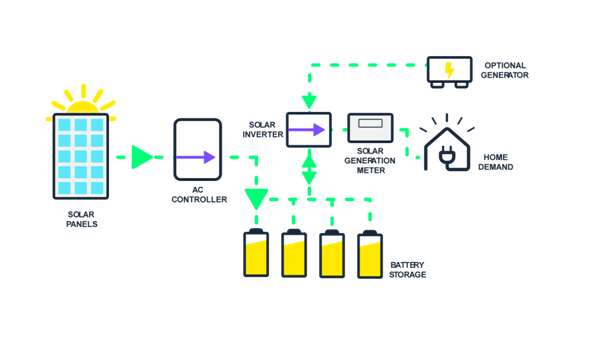WHAT IS A SOLAR PV SYSTEMS
A Solar PV (Photovoltaic) system, is a green energy solution, which generates renewable energy from the sun. Photovoltaic systems utilise solar cells to collect solar energy from sunlight and convert it into direct current, DC electricity. This electricity once passed through an inverter and converted into Alternating Current (AC) is safe to use to power your household appliances. A solar PV system is the perfect sustainable solution for anyone interested in reducing their carbon footprint and any bills. This is because generating Solar Energy doesn’t produce any pollutants and is free.
THE DIFFERENT KINDS OF SOLAR PV SYSTEM
There are three main types of solar PV systems: grid-tied, hybrid and off-grid. Each type of solar panel system has their advantages and disadvantages and it really comes down to what the customer wants to gain from their solar panel installation.
ON-GRID SOLAR SYSTEM

An on-grid solar system or grid tied, is a solar PV system which connects directly to the National Grid. This kind of Solar PV System is the most common amongst home and business owners. This type of system is perfect for someone who is already connected to the Grid, yet wants to reduce their carbon footprint and energy bills.
An on-grid solar system doesn’t require a battery storage system, and is connected to the National Grid directly via a Solar or micro inverter. As the solar panels convert sunlight into energy, your home uses this green energy supply to power your appliances.
When you generate any excess solar energy, this electricity is exported back to the Grid where you are either paid through the Feed-in-Tariff or SEG. Which is an added bonus. A key advantage of an on-grid system is the security of knowing than your energy supply will always be supported by the National Grid.
One main disadvantages of this type of solar PV system, is that because it uses a grid-tied inverter, when the National Grid fails, so does you solar system. Simply meaning you won’t have any source of back up power.
HYBRID SOLAR SYSTEM

Hybrid Solar systems combine the technology of Solar Panels and Solar batteries to create a green energy solution which provides a back-up supply of energy. Although a hybrid PV system remains connected to the National Grid, any solar energy generated is first stored in a home battery solution before going to the grid.
The main advantage of a hybrid solar system is that by storing your surplus energy in a battery, you can use your solar energy to power your home during the night, and will export less energy back to the Grid.
Whats more, unlike an on-grid system, when the national grid is down, you can also draw energy from your battery supply. This is known as islanding, and is particularly ideal for property owners who live in areas prone to power outages.
Hybrid solar panel systems offer great flexibility, as when you have used up all your energy in your battery, you still have the ability to draw from the grid. This makes a hybrid solar system the perfect in between solution. As an in between solution, a hybrid solar system is more budget-friendly compared to an off-grid system, however is more expensive than an on-grid system. A huge advantage of a hybrid solar system, is that you can expand your battery storage system at any time, and because you are still connected to the grid, you can also charge your batteries from cheap-off peak rates. However, because there are more components involved in a hybrid solar system, it is less efficient compared to a grid-tied system.
OFF-GRID SOLAR SYSTEM

Unliked an on-grid solar system, an off-grid system has zero ties to the national grid. Making it desirable fo those who can’t connect to the grid easily or wish to be energy independant.
With energy prices rising, energy independence is more in demand than ever. A complete Off-Grid Solar System contains everything you need to generate your own solar energy. Unlike hybrid systems, Off-grid systems tend to feature back-up generators and other types of renewable sources, to ensure your battery is charged fully all year round. This is because your off-grid system is the only means of energy supply you have. Off-grid solar systems have the ability to provide electricity even in the remotest of locations. Through an off grid solar system, you can be energy self-sufficient, with a supply of power no matter where you decide to live.
Solar PV system STD calculation chart.
| Monthly Light bill | Capcity in Kw | Area | Units Produced yearly |
|---|---|---|---|
| ₹1,000 | 1kw | 100sft | 1,300 |
| ₹5,000 | 5kw | 500sft | 6,500 |
| ₹10,000 | 10kw | 1000sft | 13,000 |
| ₹25,000 | 25kw | 2500sft | 32,500 |
| ₹50,000 | 50kw | 5000sft | 65,000 |
